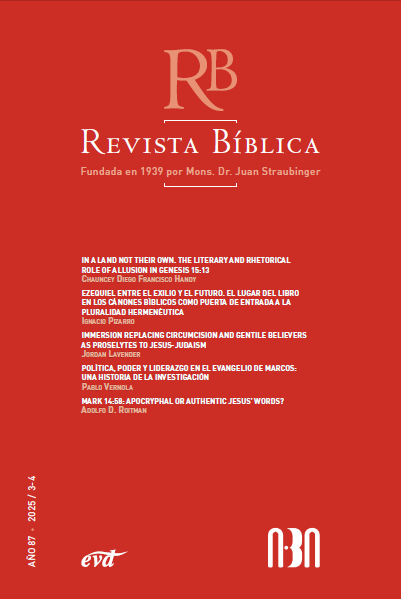Mark 14:58
Apocryphal or Authentic Jesus' Words?
DOI:
https://doi.org/10.47182/rb.87.n3-4-2025451Keywords:
ipsissima verba Iesu, early Christians, Second TempleAbstract
Contrary to the claims of earlier Christian scholars that Jesus’ words about the Temple in Mark 14:58 were apocryphal, or at most, reflected the way early Christians understood his words, my purpose in this article is to argue that this literary tradition preserved an echo of the ipsissima verba of Jesus himself. As can be concluded from some Second Temple Jewish literary sources (4Q174, Acts 7, 2 Baruch, and 4 Ezra), the ontological difference between the historical Temple “made with hands” and the eschatological one “not made with hands” was a clearcut theological topos widespread in ancient Judaism.
References
Ådna, J., “Jesus’ Symbolic Act in the Temple (Mark 11:15-17): The Replacement of the Sacrificial Cult by his Atoning Death”, en B. Ego – A. Lange – P. Pilhofer (eds.), Gemeinde Ohne Temple/Community Without Temple, Tübingen 1999, 461-475.
Assefa , D., “Dreams, Book of”, en J. J. Collins – D. C. Harlow (eds.), The Eerdmans Dictionary of Early Judaism [EDEJ], Grand Rapids (MI) – Cambridge 2010, 552-553.
Brooke, G. J., “Florilegium”, en L. H. Schiffman – J. C. Vanderka m (eds.), Encyclopedia of the Dead Sea Scrolls (2 vols.), New York 2000, 1:297-298.
Casey, M., “Culture and Historicity: The Cleansing of the Temple”, CBQ 59 (1997) 306-332.
Charlesworth, J. C. (ed.), The Old Testament Pseudepigrapha (2 vols.), New York 1983-85.
Charlesworth, J. H., (ed.), Jesus and the Dead Sea Scrolls, New York 1992.
–, The Old Testament Pseudepigrapha and the New Testament. Prolegomena for the Study of Christian Origins, Harrisburg (PA) 1998.
–, “Introduction: Devotion to and Worship in Jerusalem’s Temple”, en id., Jesus and the Temple (Textual and Archaeological Explorations), Minneapolis (MN) 2014, 1-17.
Chester, A., “The Sibyl and the Temple”, en W. Horbury (ed.), Templum Amicitiae (Essays on the Second Temple Presented to Ernst Bammel), Sheffield 1991, 37-69.
Dimant, D., “History according to the Vision of the Animals (Ethiopic Enoch 85-90)”, Jerusalem Studies in Jewish Thought 1, 2 (1982A) 18-37 (in Hebrew).
Ehrman, B. D., Jesús, el profeta judío apocalíptico, Barcelona – Buenos Aires – México 2001.
Evans, C. A., “Jesus’ Action in the Temple and Evidence of Corruption in the First-Century Temple”, en D. J. Lull (ed.), SBL 1989 Seminar Papers, Atlanta (GA) 1989, 522-539.
–, “Opposition to the Temple: Jesus and the Dead Sea Scrolls”, en James H. Charlesworth (ed.), Jesus and the Dead Sea Scrolls, New York 1992, 235-253.
Flusser, D., “Two Notes on the Midrash on 2 Sam VII”, IEJ 9/2 (1959) 99-109.
–, Jesus, Jerusalem 2009 (in Hebrew).
Freedman, D. N., “Temple Without Hands”, en A. Biran (ed.), Temples and High Places in Biblical Times (Proceedings of the Colloquium in Honor of the Centennial of Hebrew Union College-Jewish Institute of Religion. Jerusalem, 14-16 March 1977), Jerusalem 1981, 21-30.
Gross, A. D., “Temple Scroll (11QTemple)”, EDEJ, 1291-1294.
Heil, J. P., “The Narrative Strategy and Pragmatics of the Temple Theme in Mark”, CBQ 59/1 (1997) 76-100.
Hempel, Ch., “Damascus Document”, EDEJ, 510-512.
Henze, M., “Baruch, Second Book of”, EDEJ, 426-428.
Hogan, K. M., “Ezra, Fourth Book of”, EDEJ, 623-626.
Hooker, M. D., “Traditions About the Temple in the Sayings of Jesus”, BJRL 70 (1988) 7-19.
Jacobs, N. S., “Tobit, Book of”, EDEJ, 1314-1315.
Layton, B., The Gnostic Scriptures, Garden City (NY) 1987.
Moyise, S., “Jesus and Isaiah”, Neotestamentica 43/2 (2009), 249-270.
Nir, R., The Destruction of Jerusalem and the Idea of Redemption in the Syriac Apocalypse of Baruch, Atlanta (GA) 2003.
Perrin, N., Jesus the Temple, Grand Rapids (MI) 2010.
Petitfils, J. Ch., El Jesús de la historia. Reconstrucción de su vida según el método histórico y los hallazgos más recientes, Madrid 2013.
Qimron, E., The Dead Sea Scrolls – The Hebrew Writings (3 vols.), Jerusalem 2010-2013.
Regev, E., “Moral Impurity and the Temple in Early Christianity in Light of Ancient Greek Practice and Qumranic Ideology”, HTR 97/4 (2004) 383-411.
Roitman, A. D., Envisioning the Temple. Scrolls, Stones, and Symbols, Jerusalem 2003.
–, Del Tabernáculo al Templo. Sobre el espacio sagrado en el judaísmo antiguo, Estella, 2016.
Rousseau, J. J. – Arav, R., Jesus and His World: An Archaeological and Cultural Dictionary, Minneapolis (MN) 1995.
Sanders, E. P., Jesus and Judaism, Philadelphia (PA) 1985.
Schwartz, D. R., “The Three Temples of 4 Q Florilegium”, RQ 10/1 (1979) 83-91.
Stone, M. E., Fourth Ezra, Minneapolis (MN) 1990.
Sylva, D. D., “The Meaning and Function of Acts 7:46-50”, JBL 106-2 (1987) 261-275.
Sweet, J. P. M., “A House Not Made with Hands”, en W. Horbury (ed.), Templum Amicitiae. Essays on the Second Temple Presented to Ernest Bammel, Sheffield 1991, 368-390.
Thackeray, H. St. J., Josephus with an English Translation, vol. III: The Jewish War, Books IV-VI, London – Cambridge (MA) 1928; reprinted 1961.
Taylor, N. H., “Stephen, the Temple, and Early Christian Eschatology”, RB 110/1 (2003) 62-87.
Vermes, G., The Dead Sea Scrolls in English (revised and extended fourth edition), London 41995.
Wassen, C., “The Use of the Dead Sea Scrolls for Interpreting Jesus’s Action in the Temple”, Dead Sea Discoveries 23/3 (2016) 280-303.
Winkle, R. E., “The Jeremiah Model for Jesus in the Temple”, AUSS 24 (1986) 155-172.
Whitters, M. F., “Jesus in the Footsteps of Jeremiah”, CBQ 68/2 (2006) 229-247.
Wold, B., “Florilegium and Testimonia”, en B. Embry – R. Herms – A. T. Wright (eds.), Early Jewish Literature. An Anthology (2 vols.), Grand Rapids (MI) 2018, 1:501-504.
Yadin, Y., The Temple Scroll, Jerusalem 1983.
Published
How to Cite
Issue
Section
Copyright (c) 2025 Revista Bíblica

This work is licensed under a Creative Commons Attribution-NonCommercial-ShareAlike 4.0 International License.




